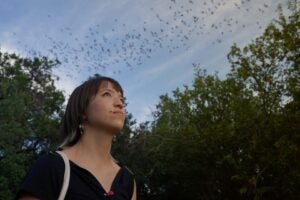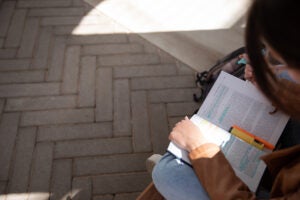AUSTIN, Texas—About 74 percent of undergraduate students at The University of Texas at Austin provided nearly three million hours of volunteer service helping in community and university projects during the 2001-02 academic year, according to a privately funded study by the RGK Center for Philanthropy and Community Service and the university’s Office of Survey Research.
The survey, released today (April 28) in conjunction with National Volunteer Week, April 27-May 3, shows these students performed volunteer service that totaled 2,997,000 hours for the academic year. The volunteer work included 45 percent serving in the community, 25 percent in university and community functions, and four percent solely in university functions. Students who volunteered were most likely to have done so because they felt compassion towards people in need or because they wanted to gain a new perspective.
The student volunteer work included 29 percent for education-related activities, 23 percent for religious organizations, 17 percent for professional groups and organizations, 17 percent for youth development/mentoring programs and 16 percent student government and related work.
Women accounted for 55 percent of the volunteers and men for 45 percent. Seventy-seven percent of African American and Hispanic students volunteered, followed by 74 percent of Anglos, 73 percent of Asian Americans and 65 percent of international students.
Volunteers spent a mean of 111 hours volunteering during the academic year. Undergraduate men served an average of 76 hours and women an average of 89 hours. Hispanicstudents reported 100 hours of service, Asian American students 85 hours, Anglostudents contributed 81 hours, African American students volunteered 67 hoursand international students served 47 hours.
Students who reported membership in Greek sororities and fraternities, as well as other organizations, served the most, reporting an average of 144 hours ofservice. Students who reported membership in non-Greek groups volunteered 92hours, while students with no membership affiliation volunteered 60 hours.
“It is very encouraging to see so many students from The University of Texas at Austin engaged in volunteering to help others,” said Curtis Meadows, director of the RGK Center. “It bodes well for our state and nation that while seeking an education for future leadership, they are also preparing to shape and support more caring and civil societies, here and around the world.”
Volunteerism at The University of Texas at Austin appears to be considerably higher than the nationwide percentage reflected by a December 2002 report by the Bureau of Labor Statistics of the U.S. Department of Labor. It noted that 27.6 percent of the nation’s civilian non-institutional population age 16 years and over volunteered through or for organizations at some point during the period from September 2001 to September 2002. The volunteers in the survey spent a median of 52 hours volunteering during the year.
The Independent Sector, a non-profit, non-partisan coalition of more than 700 national organizations representing tens of thousands of charitable groups, conducted a survey showing that 44 percent of the nation’s population 18 years of age and older was involved in volunteer service during the year 2000.
Data for the report on volunteerism at The University of Texas at Austin resulted from a survey of 1,514 undergraduate students completed in spring 2002. The sample was composed of students who were enrolled in spring 2002 and who had phone numbers on record with the university. The demographic characteristics of the sample closely match those of the student population from which it was drawn. For example, 53 percent of the sample is female compared to 51 percent of undergraduate students enrolled in spring 2002. In terms of race, the sample matches the undergraduate population enrolled during that period. About four percent of the student population and sample were African American, 16 percent of both were Asian American, 14 percent of the student population and 13 percent of the sample were Hispanic, four percent of both the sample and population were international and 62 percent of the population versus 63 percent of the sample were Anglo.
The Independent Sector, a national coalition of more than 700 organizations, foundations and corporate philanthropy programs that collectively represent the nonprofit sector, calculates the value of volunteer time and updates the value annually. The dollar value figure is based on the average hourly earnings of nonagricultural workers as determined by the U.S. Bureau of Labor Statistics, which is then increased by 12 percent to estimate for fringe benefits. At the 2001 value of $16.05 per hour, the estimated dollar value of the volunteer service provided by undergraduate students from The University of Texas at Austin is $48,101,850.
The study shows that many of the students who volunteer in college also had provided volunteer service while in high school, often with other members of their family.
African American students participated in the greatest variety of volunteer activities (slightly more than two affiliations), followed by Hispanic, Asian American, Anglo and international students. While much of the volunteering activity took place off campus, a significant amount of that activity was organized by on-campus student organizations.
Students of the colleges of Education and Fine Arts and unidentified academic majors served in at least two organizations. Topping the list with three affiliations are students who were members of both Greek and other student organizations.
Seventy-six percent of freshmen, 74 percent of sophomores and juniors, and 73 percent of seniors reported serving. The College of Education reported the largest percentage of students engaged in service at 82 percent, followed by Business majors (76 percent), Liberal Arts (76 percent), Fine Arts (76 percent) and “other,” which includes schools such as Pharmacy, Nursing and Social Work, with 76 percent of these students volunteering.
The study shows that students were generous with their resources as well as their time. Sixty percent of students gave money; 21 percent gave only to non-Sept. 11-related causes, 19 percent gave only to Sept. 11-related causes and 20 percent gave to both types of causes. Of the students who contributed money, 65 percent reported giving less than $50 to all causes, while 35 percent contributed more than $50. Churches and religious organizations received 12 percent of the student donations and health organizations received 10 percent of the contributions.
More information about the study is available on the RGK Center Web site.
For more information contact: Sarah Jane Rehnborg, RGK Center, 512-475-7616, or Robert D. Meckel, Office of Public Affairs, 512-475-7847.



